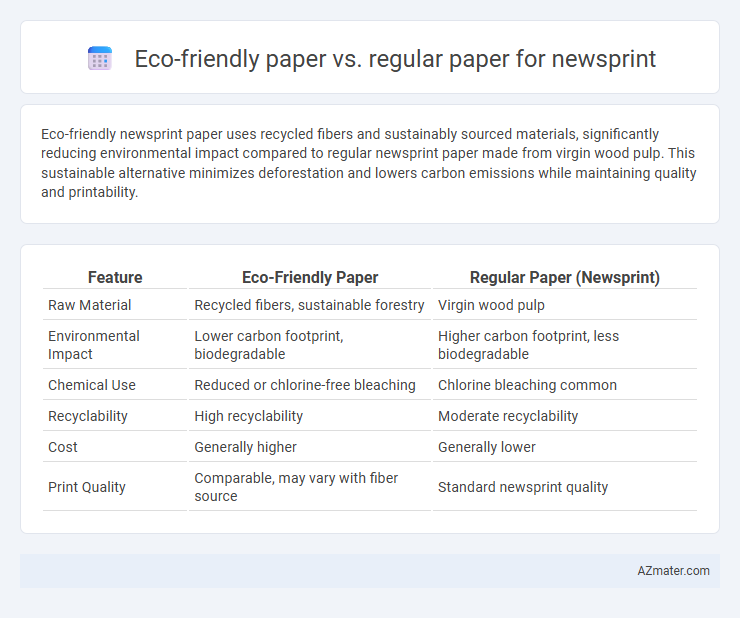Eco-friendly newsprint paper uses recycled fibers and sustainably sourced materials, significantly reducing environmental impact compared to regular newsprint paper made from virgin wood pulp. This sustainable alternative minimizes deforestation and lowers carbon emissions while maintaining quality and printability.
Table of Comparison
| Feature | Eco-Friendly Paper | Regular Paper (Newsprint) |
|---|---|---|
| Raw Material | Recycled fibers, sustainable forestry | Virgin wood pulp |
| Environmental Impact | Lower carbon footprint, biodegradable | Higher carbon footprint, less biodegradable |
| Chemical Use | Reduced or chlorine-free bleaching | Chlorine bleaching common |
| Recyclability | High recyclability | Moderate recyclability |
| Cost | Generally higher | Generally lower |
| Print Quality | Comparable, may vary with fiber source | Standard newsprint quality |
Introduction to Newsprint Paper Types
Newsprint paper primarily consists of two types: eco-friendly and regular newsprint, each differing in manufacturing processes and environmental impact. Eco-friendly newsprint uses recycled fibers and sustainable production methods, significantly reducing deforestation and chemical pollution compared to conventional newsprint derived from virgin wood pulp. Choosing eco-friendly newsprint supports sustainability goals while maintaining print quality and cost efficiency for mass circulation newspapers.
Defining Eco-Friendly Paper
Eco-friendly paper for newsprint is made from recycled fibers or sustainably sourced materials, reducing environmental impact by minimizing deforestation and decreasing carbon emissions during production. It often incorporates chlorine-free bleaching processes and uses less water and energy compared to regular paper, which is typically produced from virgin wood pulp with chemical-intensive methods. These sustainable practices ensure eco-friendly newsprint supports conservation efforts while maintaining print quality.
Composition of Regular Newsprint Paper
Regular newsprint paper primarily consists of low-cost wood pulp fibers derived from softwoods and hardwoods, often mechanically processed through groundwood pulping. This composition results in a lower brightness and a shorter lifespan due to the high lignin content, making it prone to yellowing and brittleness over time. Unlike eco-friendly paper alternatives that utilize recycled fibers or sustainable sources, regular newsprint paper lacks extensive chemical treatment or bleaching processes, contributing to environmental concerns such as deforestation and higher carbon emissions.
Environmental Impact: Eco-Friendly vs Regular Paper
Eco-friendly newsprint paper significantly reduces environmental impact by utilizing recycled fibers and sustainably sourced materials, minimizing deforestation and conserving natural resources. Regular newsprint paper relies heavily on virgin wood pulp, contributing to greater carbon emissions, habitat destruction, and higher water consumption during production. The use of eco-friendly paper also decreases landfill waste due to its biodegradability and enhanced recyclability, promoting a circular economy in the printing industry.
Energy and Water Consumption in Production
Eco-friendly paper for newsprint significantly reduces energy consumption by utilizing recycled fibers and sustainable production processes, cutting energy usage by up to 40% compared to regular paper. Water consumption in the manufacturing of eco-friendly paper is minimized through closed-loop systems and advanced water recycling, decreasing water usage by approximately 60%. These sustainability measures in eco-friendly paper production contribute to a substantial reduction in the environmental footprint relative to conventional newsprint paper manufacturing.
Print Quality Comparison
Eco-friendly paper for newsprint utilizes recycled fibers and sustainable sources, often resulting in a slightly rougher texture and lighter color compared to regular paper, which can impact ink absorption and sharpness. Regular paper, typically made from virgin pulp, offers higher brightness and smoother surfaces, facilitating crisper text and images with more vibrant color reproduction. While eco-friendly newsprint may exhibit marginally lower print quality, advances in recycling technology have minimized these differences, maintaining acceptable clarity and durability for most newsprint applications.
Cost Analysis: Short-term and Long-term
Eco-friendly paper for newsprint typically incurs higher short-term costs due to sustainable sourcing and specialized processing methods, impacting initial budget allocations. Over the long term, eco-friendly paper reduces expenses through improved resource efficiency, lower waste management fees, and potential government incentives for sustainable practices. Conversely, regular paper offers lower upfront costs but may result in higher long-term environmental liabilities and increased regulatory compliance expenses.
Biodegradability and Recycling Potential
Eco-friendly paper used for newsprint offers significantly higher biodegradability compared to regular paper, breaking down more rapidly in natural environments and reducing landfill impact. Its enhanced recycling potential stems from the use of sustainable fibers and fewer chemical additives, resulting in cleaner pulp that can be recycled multiple times without compromising quality. These properties position eco-friendly newsprint paper as a more sustainable choice for minimizing environmental footprint in print media industries.
Industry Adoption and Reader Perceptions
Eco-friendly paper for newsprint gains industry adoption due to growing demand for sustainable products and regulatory pressures reducing carbon footprints. Publishers increasingly select recycled fibers and chlorine-free processes to lower environmental impact while maintaining print quality. Reader perceptions favor eco-friendly newsprint when sustainability credentials are transparent, enhancing brand loyalty and willingness to support green initiatives.
Future Trends in Newsprint Sustainability
Eco-friendly paper for newsprint is gaining momentum due to its reduced environmental impact, utilizing recycled fibers and sustainable forestry practices to lower carbon footprints and deforestation rates. Innovations such as chlorine-free bleaching and soy-based inks enhance recyclability and biodegradability, aligning with regulatory pressures and consumer demand for greener media products. Future trends indicate a significant shift toward circular economy models in newsprint production, emphasizing resource efficiency and waste minimization to meet sustainability goals by 2030.

Infographic: Eco-friendly paper vs Regular paper for Newsprint
 azmater.com
azmater.com